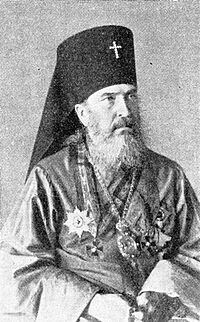Nicholas of Japan facts for kids
Quick facts for kids SaintNicholas (Kasatkin) of Japan |
|
|---|---|

Saint Nicholas
|
|
| Equal-to-the-Apostles, Archbishop of Japan | |
| Born | Ivan Dmitrovich Kasatkin 13 August [O.S. 1 August] 1836 Smolensk, Russian Empire |
| Died | 16 February 1912 (aged 75) Tokyo City, Empire of Japan |
| Venerated in | Eastern Orthodoxy |
| Canonized | 1970, Tokyo, Japan |
| Major shrine | Tokyo Resurrection Cathedral |
| Feast | 3 February 16 February (old style) |
Saint Nicholas (Kasatkin) was a very important Russian Orthodox priest, monk, and bishop. His birth name was Ivan Dmitrovich Kasatkin. He was born on August 13, 1836, and passed away on February 16, 1912.
He is famous for bringing the Eastern Orthodox Christian Church to Japan. The main Orthodox church in Tokyo, called the Tokyo Resurrection Cathedral, is often known as Nikorai-do. This name honors Saint Nicholas and his amazing work in Japan.
Contents
Early Life and Calling
Nicholas was born in a place called Smolensk in the Russian Empire. His father, Dimitry Kasatkin, was a Russian Orthodox deacon. Nicholas's mother sadly passed away when he was only five years old.
In 1857, he began studying at the Theological Academy in Saint Petersburg. This is where he trained to become a priest. On June 24, 1860, he became a monk and was given the name Nicholas. Soon after, he became a deacon and then a priest.
He heard about a need for a priest at the Russian consulate in Hakodate, Japan. He felt called to go there. He volunteered for this important job.
Starting the Church in Japan
On July 2, 1861, Nicholas arrived in Hakodate, Hokkaidō, Japan. He was the priest for the Russian consulate's chapel. When he first arrived, he spent eight years learning about Japan. He studied the Japanese language very carefully. He also learned about Japanese history, culture, and Buddhism. He wanted to understand the people deeply.
While working at the consulate, he helped three Japanese people become Orthodox Christians. One of them was Sawabe Takuma, a former samurai and Shinto priest. Interestingly, Sawabe had first come to Nicholas's home planning to harm him. But after talking with Nicholas, he changed his mind and became a Christian. Sawabe later became one of the first Japanese Orthodox priests.
In 1870, Nicholas moved to Tokyo. He started a big effort to share the Christian faith. He bought land in Kanda Surugadai for his main church. This place later became the center for the Orthodox Church in Japan.
Growing the Orthodox Community
Under Nicholas's leadership, the Orthodox community in Japan grew a lot. By 1870, there were more than 4,000 Orthodox Christians. By the time he passed away in 1912, there were about 33,000 people. They had 266 Orthodox communities across Japan.
Nicholas became a bishop on March 30, 1880. He helped build the Tokyo Resurrection Cathedral, which was finished in 1891. In 1907, he was given the title of Archbishop of All Japan.
During the Russo-Japanese War
The Russo-Japanese War (1904-1905) was a very hard time for Nicholas. He was Russian but lived in Japan. He loved both his home country and the country where he served. He had to support his Japanese followers and pray for the Japanese emperor and army.
During the war, Nicholas did not lead public church services. Instead, he told his Japanese followers to pray for and help their country. He also helped Russian prisoners of war in Japan. He sent priests and teachers to their camps. He was surprised that many Russian soldiers could not read. Nicholas's kindness and actions during this difficult time impressed many people, both Christians and non-Christians.
Nicholas's Character and Legacy
Even Emperor Meiji of Japan was impressed by Nicholas. Nicholas worked hard to help solve problems between the Russian and Japanese governments. For example, he helped after an incident where the Russian Tsar Nicholas II (who was a prince at the time) was injured in Japan.
Nicholas's deep study of Japanese helped him greatly. He translated many important religious books into Japanese. This included the entire New Testament and Psalms from the Bible. He also translated parts of the Book of Genesis and the Book of Isaiah. He worked with a Japanese scholar named Nakai Tsugumaro. These translations are still used in Japanese Orthodox churches today.
Nicholas also loved church singing. He helped bring this beautiful art to Japan. He started a school for future priests, as well as schools for boys and girls. He also created a library and a shelter.
Nicholas kept a diary in Russian for many years. It recorded his life and thoughts about Japan during the Meiji period. His diary was thought to be lost in the 1923 Great Kantō earthquake. But it was found again and published in 2004.
Honoring Saint Nicholas
Nicholas was the first saint of the Japanese Orthodox Church. After he passed away, he was buried in the Tokyo Metropolitan Yanaka Cemetery. In 1970, he was officially recognized as a saint. He is called 'Equal-to-the-Apostles, Archbishop of Japan, St Nicholas'. His special day is celebrated on February 3 (Old-style calendar) or February 16 (New-style calendar).
There is a church in Maebashi, Gunma, Japan, built in 1974, that honors him. There is also an Eastern Orthodox Church in Moscow, Russia, dedicated to Saint Nicholas of Japan.
See also
- Russians in Japan

